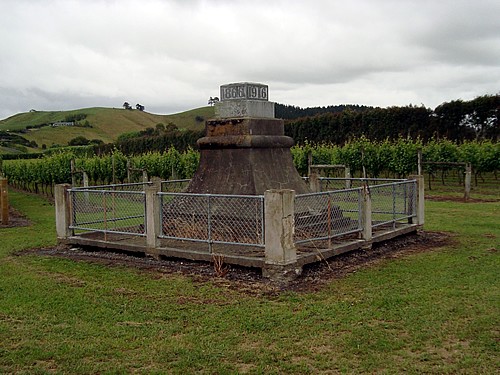
The Māori settlement (kāinga) of Ōmarunui was on the south bank of the Tūtaekuri River, about 13 km south-west of Napier. On the morning of 12 October 1866, the kāinga was the scene of a battle in which settlers and local Ngāti Kahungunu fought a Pai Mārire (Hauhau) faction of Ngāti Hineuru.
This memorial stands on the site of Ōmarunui, about 4 km south-west of the Napier suburb of Taradale. It is situated on the edge of a vineyard on Omarunui Road, 2 km from the junction with Korokipo Road (State Highway 50).
The Pai Mārire movement arrived on the east coast of the North Island in 1865. In Hawke’s Bay it found strong support within Ngāti Hineuru, an inland iwi with its principal kāinga at Te Hāroto and Tarawera on the present Napier–Taupō Road (State Highway 5).
In early October 1866, Ngāti Hineuru chief Te Rangihiroa and the Pai Mārire prophet Panapa led 80 men in an ‘advance’ on Napier. The party occupied Ōmarunui. The kāinga’s leader, Pāora Kaiwhata of Ngāti Kahungunu, had taken most of his people to Pā Whakairo, Tareha Te Moananui’s strongly fortified pā 1½ km away.
(A mounted group of 25 Ngāti Hineuru men led by Te Rangihiroa and Pāora Toki subsequently arrived from the interior, reportedly to attack Napier from the north but more likely to reinforce their kinfolk at Ōmarunui. On the morning of the engagement at Ōmarunui this group was ambushed by Hawke’s Bay Military Setters at Pētane.)
Ōmarunui’s new occupants ‘remained quiet and refrained from any act of violence’. However Donald McLean, Superintendent of Hawke’s Bay Province, was anxious to know their intentions. Panapa’s ambiguous response – that peace and war were both good – led McLean to act with force.
Just after midnight on 12 October, 200 European militia marched out of Napier under the command of Colonel George Whitmore. They were joined by 200 Ngāti Kahungunu whose leaders included Kaiwhata, Tareha, and Rēnata Kawepō.
By daybreak Ōmarunui was nearly surrounded. When Panapa rejected an invitation to surrender, Whitmore ordered heavy fire to be concentrated on the kaingā’s meagre defences from three sides.
Panapa was killed during the firing, which lasted more than an hour. Most of the Ngāti Hineuru who attempted to escape through the rear of the pā were captured, wounded or killed. When the remaining defenders raised a white flag, Whitmore ordered a ceasefire.
Two Europeans – one of them Private W. Young – were killed and nine wounded. Two Ngāti Kahungunu were killed and four wounded. It is thought that 23 Ngāti Hineuru dead were buried in the pā, while another 30 or so were wounded.
The Ngāti Hineuru taken prisoner were exiled to the Chatham Islands, from where they escaped with Te Kooti Arikirangi Te Turuki on 4 July 1868. Several of those captured at Ōmarunui, including Nikora, Petera Kahuroa and Te Rangitahau, were among Te Kooti’s most loyal lieutenants during the guerrilla campaign that followed (1868–72).
In March 1916, 30 ‘enthusiastic’ Ōmarunui veterans met in Napier’s Athenaeum building to discuss ‘means and ways’ of commemorating the engagement. After some discussion the meeting agreed to hold an anniversary picnic at Ōmarunui and erect a memorial on land already donated by W. Kinross White. (Similar arrangements were made to commemorate the Pētane ambush.) A committee was formed to meet descendants of the chiefs of ‘friendly natives’ to discuss the arrangements.
The octogenarian J.D. Ormond, who had been the local member of Parliament at the time of the battle, unveiled this memorial at Ōmarunui on its 50th anniversary, 12 October 1916. The ceremony, which took place in pouring rain, was attended by New Zealand Wars veterans from around the country. Only the base of the original monument remains; the structure was deliberately damaged in the early 1990s.
Further information
- ‘Fight at Omaranui – Twenty Three Hau-Haus Killed’, Colonist, 19 October 1866
- ‘Further Particulars’, Colonist, 19 October 1866
- ‘Another Engagement – Twelve Rebels Killed’, Colonist, 19 October 1866
- ‘Meeting of War Veterans’, Colonist, 24 March 1916
- ‘Interprovincial’, Poverty Bay Herald, 12 October 1916
- John Battersby, The one day war: the battle of Omarunui, 1866, Reed Books, Auckland, 2000
- James Belich, ‘A New Kind of War’, in The New Zealand Wars and the Victorian interpretation of racial conflict, Penguin, Auckland, 1998, pp. 203–34
- James Cowan, ‘Captured at Omarunui’, in New Zealand Railways Magazine, vol. 12, issue 11 (1 February 1938), pp. 25–30
- James Cowan, ‘The Fight at Omarunui’, in The New Zealand Wars: a history of the Maori campaigns and the pioneering period: volume II: the Hauhau Wars, 1864–72, R.E. Owen, Wellington, 1956, pp. 137–42
- Ken Te Huingarau Gartner, ‘Te Rangitahau - Biography’, Dictionary of New Zealand Biography. Te Ara - the Encyclopedia of New Zealand, updated 1 September 2010
- Thomas Lambert, The story of old Wairoa and the East Coast district, North Island, New Zealand, Coulls, Somerville, Wilkie, Dunedin, 1925 (reprinted with index by Reed, Auckland, 1998), pp. 600–11
- Chris Maclean and Jock Phillips, The sorrow and the pride: New Zealand war memorials, GP Books, Wellington, 1990, p. 29
- Patrick Parsons, ‘Kaiwhata, Paora - Biography’, Dictionary of New Zealand Biography. Te Ara - the Encyclopedia of New Zealand, updated 1 September 2010
- Nigel Prickett, ‘The East Coast, 1865–66’, in Landscapes of conflict: a field guide to the New Zealand Wars, Random House, Auckland, 2002, pp. xxx, 125–31

Community contributions